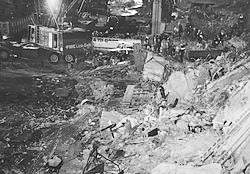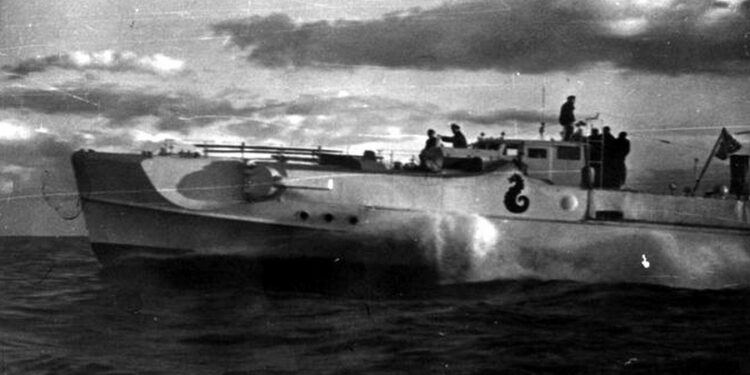By early August 1941, the war on Mediterranean communications took an unfavorable turn for the Axis. Since all the Yugoslav warships captured in April were transferred to the Italians, the Germans could strengthen their presence in the Mediterranean in only two ways – to send submarines there from the Atlantic through the Strait of Gibraltar, or to transfer boats from the North Sea along rivers and canals. They chose the second way.
On August 5, the Kriegsmarines informed the High Command of the Wehrmacht about their readiness, after the end of the active phase of operations in the Baltic, to allocate for this purpose a flotilla of snellbots and a flotilla of raumbots. At the same time, the Headquarters for the leadership of the war at sea estimated the time required for the overhaul of torpedo boats and their transition from Rotterdam along the Rhine system of canals and the Rhone to La Spezia, in 2-3 months. For redeployment, the 3rd flotilla of snellbots of Lieutenant-Commander Friedrich Kemnade and the 6th flotilla of raumbots were selected. The passage along the southern French waterways was agreed with the government of Marshal Petain.
Until the end of September, the 3rd Flotilla was concentrated in Wilhelmshaven. It consisted of boats of the S-30 series with three 16-cylinder diesel engines “Daimler-Benz” MB502, which had a maximum speed of 36 knots with a displacement of 81 tons, a length of 32.7 meters and a width of 4.9 meters, a draft of 1.9 meters, maximum permissible for passage on its own through river channels. They were armed with a 20-mm automatic cannon “Rheinmetall” C / 30, mounted on the poop (later a second 20-mm cannon was installed in the bow), and two 533-mm torpedo tubes, as well as two rails at the stern for dropping mines.
The flotilla was tasked with “directly and indirectly defending the Sicily-Tripoli communication and conducting offensive operations off Malta and the North African coast . ” Upon completion of the repairs on the morning of October 7, the first group of S-31, S-34, S-35, S-55 and S-61 headed to Rotterdam – the starting point for the transition to the Mediterranean Sea. On October 8, the boats arrived at their destination and took refuge in a bunker. From here, on October 9, S-31, S-35 and S-61 sailed up the Rhine and arrived in Mannheim on October 12, and on October 14 to Strasbourg, where the S-33 arrived two days later with the S-34.
Further passage through the Rhine-Rhône canal system was extremely difficult due to the narrow locks, of which there were 167, and low bridges. To overcome them, as well as for camouflage purposes, the boats underwent significant alterations. The bridge of each boat was cut in half in height, so that the helmsman had to stand in the open, and the cut-out was placed at the rear of the deck. A thick tube was installed over the front engine, the torpedo tubes were covered with metal sheets, and the 20-mm cannons were dismantled. Finally, the schnellboats were painted black and raised the flags of the auxiliary fleet on them, depicting the boats of the rescue service. The crews wore civilian clothes, communication with strangers was strictly prohibited, and mail correspondence and holidays were prohibited throughout the trip to the Mediterranean.
The first group arrived in La Spezia on November 18, where they were docked for a week. On November 28, the Schnellboats reached Gaeta, and on December 1 they arrived at their new base – the naval base of the Italian fleet Augusta on the east coast of Sicily.
The first cruise to Malta of five boats of the 3rd Flotilla on the night of December 13 was directed against the ships of the “K” formation based there. Reconnaissance reported about the impending exit of the British, but they did not leave the harbor, and the Germans waited for them at sea in vain. Going to Malta the next night with a similar task proved equally ineffectual. Then the Germans started mining the approaches to La Valette. The first mine laying at the entrance to Grand Harbor was carried out by the 3rd Flotilla on the night of December 17, after which three more operations followed by the end of the month. At the same time, when installing 24 TMA anchor mines fired from a torpedo tube, nine spontaneous explosions occurred, which is why the use of these mines was banned. On the night of January 19, 1942, an exit against the MW8A / MW8B convoy from Alexandria to Malta followed, but the snellboots did not find the target and returned to Augusta.
The journey of the second group (S-54, S-56, S-57, S-58 and S-59) from Wilhelmshaven to the Mediterranean lasted much longer. On the crossing of the North Sea, S-54 and S-57 were damaged due to bad weather and got up in Rotterdam for repairs. Further, the low water level in the Rhone basin delayed their advance from the Rhine by six weeks, so that they did not move on until January 10, 1942. On January 15, the second group arrived in La Spezia and only on February 5 – at the disposal of Kemnade in Augusta.
German torpedo boat S-35 – Schnellboats go to Malta | Warspot.ru
German torpedo boat S-35
The 3rd Flotilla used a base at Porto Empedocles on the southwest coast of Sicily, 120 miles from Malta, to counter British traffic across the Sicilian Strait. From here, on the night of February 6, according to air reconnaissance, they went to sea, but did not find the enemy and, due to bad weather, left for Augusta in the morning. On 20 February, the flotilla was again dispatched to Porto Empedocle, but again bad weather prevented the operation despite an air reconnaissance report of contact. On March 5, two schnellbots went out in search of the coast of Tunisia from Pantelleria. On the same day, the Headquarters for the leadership of the war at sea issued a directive on the upcoming use of the 3rd flotilla against Tobruk from the operational base in Derna and the rear base in the Souda bay in Crete and sent it to the command of the “South” group and the Admiral of the Aegean Sea to prepare for the upcoming redeployment …
But, until the order to relocate did not come, on the nights between March 15 and April 28, the snell boats of the 3rd flotilla set up 12 minefields, and the explosions of mines continued during the setting. At this time, the flotilla chalked up the first success – on one of the exposed minefields at Cape Zonkor (the extreme eastern point of Malta), 9 miles from Grand Harbor, on March 24, the destroyer escort “Southwold” (HMS Southwold) from the convoy was blown up MW-10, which defended the damaged support vessel HMS Breconshire from air raids.
At the same time, the Italian fleet completed its mine-protection activities in Maltese waters. On the afternoon of 18 April, destroyers Vivaldi and Malocello left Trapani with 156 mines on board with the task of setting up a barrage south of Malta. Proceeding to the target past Pantelleria and Linosa, the destroyers at 02: 26–02: 55 on April 19 threw mines and went through Linosa to Augusta.
Schnellboats of 3rd Flotilla in Augusta, foreground S-59 – Schnellboats heading towards Malta | Warspot.ru
Schnellboats of the 3rd Flotilla at Augusta, foreground S-59
Having loaded 156 mines there, at 13:45 on April 20, both ships went to sea for staging in the same area. At 00:43 on April 21, at an altitude of 250 meters above them, the Blenheim flew over and withdrew towards Malta. Since the Italians immediately began to intercept the radiograms, they considered that the plane was reporting them, and at 01:05 they turned back. So the mines placed on April 19 became the last obstacle in Maltese waters made by Italian ships.
Bad weather kept the German schnellboats in Augusta until the evening of May 6, when Lieutenant Commander Kemnade with S-61, S-31 and S-34 set out to place an additional barrier on the approaches to Grand Harbor. Three air raids were sounded in Malta that night – Junkers Ju 88 bombers dropped bombs in pairs on Gozo, Luka, Safi, Ta-Kali and Mosta. Schnellboats traveling to the area east of Malta at 00:16 on May 7 noticed the explosions of bombs on the island. At 00: 41–00: 50, they set mines in a given area, after which they moved westward. A weak north-westerly wind was blowing in the area of operation, and visibility was good.
At 01:26, S-31 reported a silhouette along a bearing of 310 °. At 01:27, the boats in a dense column with intervals of 50 meters between at 15 knots were turned on the enemy, who was heading north-west at an average speed. It was an unsuspecting ML-130 British patrol boat that was sailing along a well-worn channel and ignored the warning signals from the shore.
After overtaking the target on a parallel course 4.5 miles northeast of Marsascala, at 01:39 all German boats from about 200 meters opened fire from their starboard side from their four 20mm cannons. Immediately, hits were noted in the bridge and stern of the British. The enemy, taken by surprise, responded only a few minutes later – at 01:43 the flagship S-61 received a direct hit from a 47-mm projectile in front of the bridge under the torpedo tube. The Englishman, however, stopped, remained behind the battle formation of the Schnellbots, and the Germans stopped the fire.
British minesag cruiser “Welshman” – Schnellboats go to Malta | Warspot.ru
British cruiser minesag “Welshman”
At 01:45, the schnellbots turned to the right to fight on a collision course on the starboard side. At 01:47 the fire was again opened already in the formation of the left bearing. ML-130 fired back. Having passed him astern, Kemnade stopped shooting at 01:51 and again turned to the right to continue the battle with his starboard side. At 01:56 the Germans began shelling already from 100 meters, observing fires in the middle and bow of the enemy. At 01:57 they ceased fire and turned to the right for the last time in order to resume combat on a head-on course on the starboard side and finish off the enemy from a minimum distance. After the shelling at 02: 00–02: 04, the Briton stopped firing and began giving signals for help with a searchlight.
At 02:15, Kemnade turned to the right and demanded surrender in a megaphone, to which he received an affirmative answer, but the British did not lower the flag, since many of the survivors were wounded and the flag line was broken. Kemnade ordered the remaining crew members to assemble on the tank, which was done. The lack of excitement made it possible to remove them, becoming side to side, but fearing that the British could detonate 12 depth charges stacked on the backdeck, the Germans used rubber boats from S-34 and S-31.
ML-130 heeled to starboard and burned on a twin deck aft. His towing and drive to the base under these circumstances were very problematic, so after several nautical charts were picked up from the bridge and from the water, a double-barreled 7.7-mm machine gun was removed, and the English flag was finally lowered, Kemnade decided to blow up the enemy by setting two explosive cartridges for depth charges. At 03:01 the depth charges were detonated, after which the Kemnade boats with 11 prisoners, led by Lieutenant Jolly, left for Augusta. The Germans had one wounded in this battle in an S-31; the British had three crew members reported missing, another died of wounds in captivity.
On the night of May 8, S-61, S-31 and S-34 laid a minefield east of Malta, and the Schnellboots that went out to mine the next night noticed the trawlers leaving the harbor, but did not attack them, having orders to carry out the task without detecting yourself.
British trawler “Beryl” – Schnellboats go to Malta | Warspot.ru
British trawler “Beryl”
On the afternoon of May 9, German aerial reconnaissance reported a “cruiser heading to Malta on its own,” with an expected arrival time before dawn on May 10. It was the mine-slug cruiser Welshman, which sailed from Gibraltar to La Valletta on 7 May with 540 tons of cargo – medicine, food, ammunition, spare parts for the Spitfires, as well as passengers from the Royal Air Force ground personnel. Minzag was disguised as the French leader Leopard and was sailing under the French flag when, at 10:00 on May 9, it was discovered by a Ju 88 reconnaissance officer. without any special adventures arrived at the destination, the British concluded that the camouflage worked.
In fact, the Welshman was identified, and the German naval command dispatched the 3rd Schnellboat flotilla to intercept. According to the plan of the operation, S-54, S-56, S-57 and S-58 were waiting for the mine layer at the Bay of St. Thomas on the southeast coast of Malta. S-61, S-31 and S-34 first set up minefields at Cape Sliema at the northern entrance to La Valletta harbor, and then had to retreat east and attack the Welshman with torpedoes if it enters Grand Harbor from northeast.
The Schnellbots left Augusta on May 9 at 22:00. At 04: 14–04: 21, the mining group placed 20 mines and eight mine defenders in the assigned area and was moving east when S-31 hit one of the newly laid mines, which fell off anchor and surfaced. At 04:38 the boat sank, 13 people died, the same number survived and were rescued by the quickly approaching S-61. The explosion occurred a mile from the coast, and the British searchlights began to ransack the adjacent waters, but the snellboats had already gone southeast. Then the S-61 and S-34 fired four torpedoes into the cruiser, which missed the target – the Welshman did not notice either enemy boats or torpedoes fired, but a big commotion was caused by the right paravan sweeping two mines at the entrance to Grand Harbor.
The second group of snellbots had an unsuccessful skirmish with the trawler “Beryl”, from which they noticed the traces of three torpedoes, and the drifter “Trust Star”, after which they withdrew to the northeast.
Having unloaded before 13:30 under the cover of smoke from generators delivered by it, the Welshman safely left La Valletta at 21:30 on May 10. The evening exit of the trawling forces did not end so successfully – all the minesweepers returned to the harbor at 02:30, but the tug C.308 at about 03:00 on May 11 was blown up by a mine and sank with nine dead crew members.
British Drifter “Eddie” – Schnellbots head for Malta | Warspot.ru
British drifter “Eddie”
A new exit of the 3rd flotilla schnellbots for mining followed on the night of May 17: S-59, S-34, S-58 and S-35 set up a barrage close to the coast of Malta. Shortly after 01:00, the British heard the sound of engines working off the coast in the northern part of the island and turned on the searchlights, but did not notice anyone, although one of the batteries fired two shells at an invisible target. At 02:04, “four boats hit the beams of searchlights and were fired upon by the guns of Fort Tigne from 10,000 yards . ” The Germans disappeared behind a smokescreen, but after a few minutes they again fell into the beams of searchlights and were fired upon from the forts of Tigne and Rocco, which fired 22 shells. The Germans again covered themselves with smoke and fled in a northern direction.
However, not everyone managed to escape – the S-34 received a direct hit in the engine room. Three crew members were killed, the rest were taken on board by S-59, after which they tried to flood the boat with explosive charges – at 02:35 at 050 ° bearing from Fort San Elmo, the British recorded an explosion. Since the boat did not sink, the Germans reported this to the base and left the dangerous waters. At dawn, the British spotted a speedboat 10,000 yards east of San Elmo and fired at it from Fort Rocco, claiming another direct hit. Then, one by one, the stationary target was attacked by the Hurricanes and specially called Messerschmitts Bf 109, which finished off the drifting boat.
After 24 mines, during which 557 mines and 416 defenders were deployed, the activities of the schnellboats in the Malta area were suspended – on May 18, an order was received to prepare for relocation to North Africa. Already on May 21, S-54, S-56, S-57, S-58 and S-59 left for Navarin in order to reach Derna through the Souda bay, where, with the support of army engineers, a base with bunkers for boats, warehouses and barracks. On 23 May, the four other Schnellboats of the flotilla followed them from Livorno via Augusta.
British sweeping forces went out to sea every day. As RAF fighters took control of the air situation, exits were resumed during daylight hours. Early on the morning of May 24, a trawling group – Eddie, St Angelo, Beryl, Swan and Trust Star – left Grand Harbor under cover of darkness to clear the fairway north of La Valetta , but due to unfavorable weather conditions the work had to be curtailed; only one mine was defused. At 4:30 pm, on the way back to port, a mile from Cape San Elmo, the Eddie drifter hit a drifting mine and sank; eight of the 19 crew members were killed.
British tugboat St. Angelo – Schnellboats sail to Malta | Warspot.ru
British tug “St. Angelo”
On May 30, it was the turn of the tug “Saint-Angelo” – leaving the harbor with the trawlers “Beryl”, “Swan” and the drifter “Trust Star”, he destroyed six mines, but on the way back, less than a mile from the pier, it blew up and sank with four crew members.
On June 10 “Beryl”, “Swan” and “Trust Star” set out for another trawling, which was the last for Trusty Star – when returning at 4:40 pm, 3 miles northeast of San Elmo, it was blown up by a mine and sank. ML-126, which at the time was trawling the entrance channel into Grand Harbor, was “attacked by three Bf 109s, but knocked down one of them and damaged the other,” while the commander and three sailors were slightly injured from air shelling.
Help was close. On June 12, convoy Harpoon left Gibraltar, along with four naval minesweepers of the 17th flotilla of Lieutenant-Commander Peter Doran – Speedy, Hythe, Paradise (Rye) and “Hibi” (Hebe) and the other six boats of the ML type of the 3rd flotilla.
Due to the delay as a result of the battle at Pantelleria, the remnants of the convoy approached Malta in the dark on 15 June. The air defense cruiser Cairo and the escort destroyers, instead of heading west and crossing the Sicilian Strait under cover of darkness, were now forced to go to La Valetta to replenish ammunition. Further, the minesweepers and boats from the escort of the convoy had no idea about their duties to clear the approaches to the harbor – this was simply not planned at the meeting before the cruise in Gibraltar. In addition, the commander in Malta, Vice Admiral Ralph Leatham, who replaced Ford on 20 January, gave inaccurate information about the direction of the fairway, and the convoy commander, CC Hardy, refused to wait for the minesweepers in the tail of the order.
As a result of all this, the convoy ended up in an Italian minefield at the very entrance to the harbor. The ship “Orari” (Orari) was blown up by a mine 360 m from the pier, but remained afloat. The Polish destroyer Kujawiak was blown up and sank before being taken into tow; killed 13 crew members. The destroyer Matchless, the escort destroyer Badsworth and the minesweeper Hibi were also blown up by mines, but despite heavy damage (the latter entered the harbor with an 8-foot hole above the left side keel and damaged starboard screw), got to the harbor.
Flagship of the 17th Speedy minesweeper flotilla – Schnellboats heading for Malta | Warspot.ru
Flagship of the 17th minesweeper flotilla “Speedy”
And on June 16, when returning to the harbor, the Justifede drifter, which was performing that night as a floating beacon for the convoy ships, blew up and sank.
Already on June 17, Speedy, Hight and Paradise (Hibi were repaired) began clearing the entrance fairways to Grand Harbor. By the end of the month, minesweepers and boats had cleared a three-mile long passage, with 60 mines neutralized. In July, minesweepers increased the number of defused mines to 200. On July 5, Vice Admiral Lytham announced that the island could again be used for basing submarines. By July 12, the fairway was cleared of mines, on July 20, P-42 arrived from Gibraltar, and on July 22, other boats of the 10th Flotilla arrived from Alexandria. By the beginning of Operation Pedestal, eight British U-class submarines were based in La Valette. The minesweepers accompanied them when leaving the harbor on missions and at the entrance, and also constantly cleared the fairway for the safe passage of high-speed mines with cargo for the island.
In the first eight days of August, minesweepers neutralized 27 min. And in the final phase of Operation Pedestal, the Maltese minesweeping forces – four minesweepers of the 17th flotilla and 7 boats ML of the 3rd flotilla, ensured the passage to La Valletta of the ships of the convoy that escaped death. In the early morning of 13 August, all four minesweepers, with Commander Jack J. Jerome, commander of the trawling force in Malta, in Speedy, together with the boats ML of the 3rd Flotilla, set out to sea to meet the four ships that had reached the island. Tanker “Ohio” lost speed and Jerome sent “Paradise” and two MLs to it, and he himself with the rest of the ships brought the “Port Chalmers”, “Melbourne Star” and “Rochester Castle” ( Rochester Castle) to La Valletta around 18:00. At 08:55 the next day, Speedy, Hibi, Hite and three MLs made a connection with Rai, which was towing a huge tanker. At this time, the destroyer Penn and the destroyer escort Ledbury from the escort of the convoy joined the towing and jointly dragged the almost uncontrollable Ohio, but at 10.40 another attack from the air followed, the tanker received new damage and lost the towing line from the “Paradise”. At 12:45, the towing was resumed with the help of the destroyer Bramham, and the approaching ships of Jerome formed an air defense order around the Ohio. Then a Maltese tug approached and pulled the tanker in front, while Rai trailed the passage in front of it. At 09:30 on August 15, the minesweepers and the long-suffering Ohio with 10,000 tons of fuel entered Grand Harbor. The Brisbane Star, with its nose mutilated from a torpedo hit, came here on its own on 14 August.
For the Maltese minesweepers, Operation Pedestal was their last major test. Working with constant air support, they no longer had to face the threat of enemy air attacks. Until the end of September, the 17th flotilla defused over 300 mines, and the 3rd ML flotilla by the end of October – 100 mines.
British cutter ML-462 in Malta – Schnellboats go to Malta | Warspot.ru
British boat ML-462 in Malta
The number of miner planes has become much smaller, and the snellboats of the 3rd Flotilla that returned to Sicily resumed mine laying in Maltese waters only in November. On the night of November 3, seven schnellbots tried to mine the approaches to La Valletta, but were discovered in advance by radar and fired upon by coastal artillery, as a result of which mines were placed south of the island of Filfa, south of Malta. On the nights of November 4 and 7, the situation repeated itself. These were the last exits of the snellbots for mining to Malta. With the start of Operation Torch, they were redeployed to the Western Mediterranean.
Dredging in Maltese waters continued. In November-December, they cleared out a minefield near Filfa, destroying 33 mines. By the end of January 1943, the 17th Flotilla had defused 357 mines. In February, no mines were found, and in March another minefield was found 5 miles southwest of Filfa and 20 mines were destroyed. By the end of April, the number of defused mines reached 419. On 15 May, while eliminating, together with ML, a small Italian minefield near San Elmo, a Speedy was blown up and had been under repair for two months.
By the start of Operation Husky, Maltese waters had been cleared of mines. On August 8, 1943, the 17th Flotilla left La Valletta.












